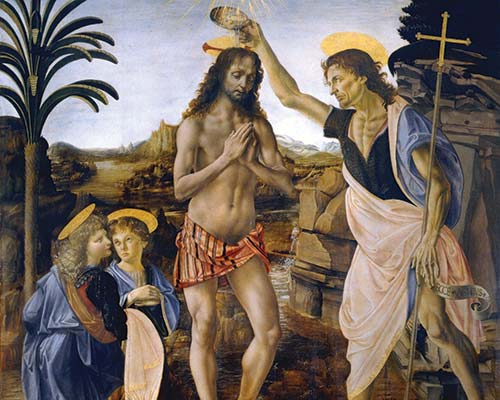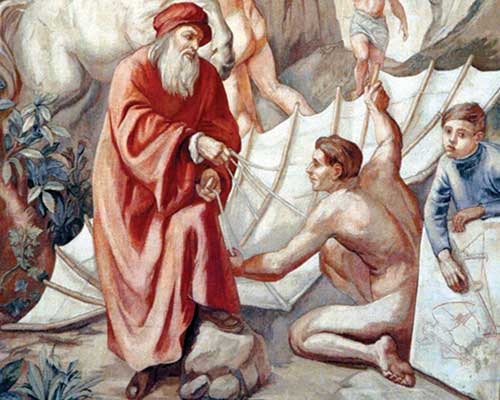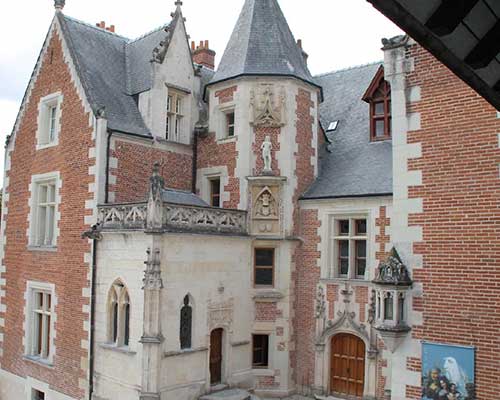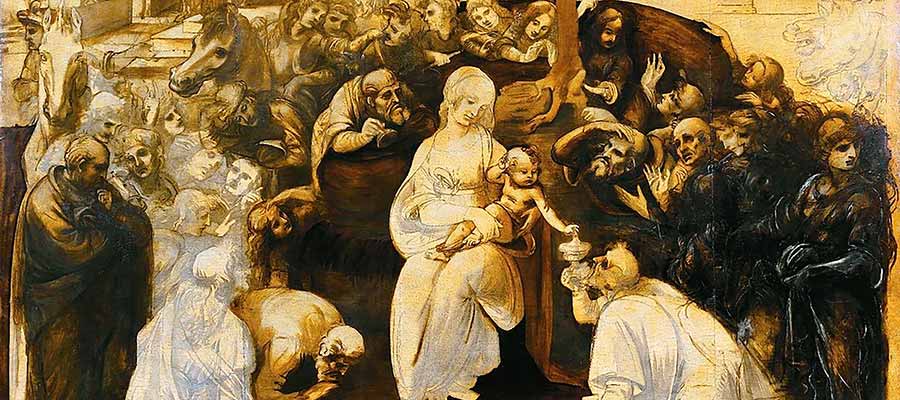Leonardo da Vinci
Biography
Leonardo da Vinci

1452
Leonardo was born on the fifteenth of April in a house of Anchiano, in the small town of Vinci. He was the first male child, though illegitimate, of Ser Pier Antonio, a Florentine notary-who later had nine sons and two daughters-and of Caterina.
1469
Leonardo’s father showed some of his son’s sketches to the artist Andrea del Verrocchio. Thus began the youth’s apprenticeship. In Andrea’s workshop, Leonardo learned the artistic techniques of painting, sculpture, and the principles of mechanics and engineering.

1505/1506
He continued his studies of flight at his dwelling in Fiesole. In April, 1506 he had his student Tommaso Masini-also known by the name of Zoroaster of Peretola-carry out an experiment with a flying machine. This attempt ended in failure.
1518/1519
In France, Leonardo came under the influence of his own apocalyptic visions. Impressive witnesses of this final period are the drawings in which the end of the world are imagined: here the fantastical event is one in which the forces of nature act with logical coherence and terrible beauty, all explored by Leonardo. On the 29th of April, 1519, he made his last will and testament.

1516/1517
Leonardo accepted the invitation of François I, the new king of France, to join his court. Already an elderly man, Leonardo took up residence at Amboise, in the castle of Clos-Lucè, with the title of the king’s chief painter.
1519
Leonardo died on the second of May, at the age of 67. His will determined that all his drawings and manuscripts would be inherited by his student Francesco Melzi, while his paintings were left to Gian Giacomo Caprotti, called The Salai. When Salai died, in 1525, Leonardo's inheritance began to be dispersed.
Florence
Da Vinci in Florence
in the workshop of Andrea del Verrocchio
Until he was seventeen years old, Leonardo remained with his mother’s family in Vinci, before moving toward Florence where, in 1469, the young man was introduced, probably thanks to his father’s social connections, to Andrea del Verrocchio, the master of one of the most prolific artistic workshops of the era, where important artists like Sandro Botticelli and Lorenzo di Credi had been trained. As in all the artistic workshops of the time, the “internship” of the young pupil was based on practice: first he had to follow the work of the master, after which he began to collaborate with him, and finally he had to strike out on his own, to start his independent activity.
For this reason, the Baptism of Christ, now on display at the Uffizi but originally destined for the Church of San Salvi in Florence, usually has been identified as Leonardo’s first important work as a painter, in collaboration with Verrocchio. The stylistic difference between the parts realized by the master, and those by his pupil, is extraordinary. Even an inexpert eye can see how Leonardo’s style stands out, in the angel who holds the clothes, and in the valley depicted in the background. This pictorial element can be related to the first definitively dated drawing, of 5 August 1573, which in fact portrays the Arno valley viewed from the slopes of Montalbano. The pictorial manner of Leonardo is softer and more delicate in its contours than the rest of the painting, and this clear stylistic difference, too evident for a novice pupil, has led some to believe that the Baptism of Christ is not the first work Leonardo carried out in collaboration with Verrocchio.
Recent critical studies concur in dating the painting instead to the final phase of Leonardo’s first Florentine period, when the artist was already semi-autonomous, and about thirty-years old. Leonardo’s first efforts as a painter therefore can be traced in paintings with a notable Verrocchian matrix, marked by the strong contours of the figures, and by the almost sculpture-like treatment of the bodies, like the Madonna of the Carnation, today at the Alte Pinakothek in Munich, Bavaria, and the famous portrait on display at the National Gallery of Washington, of Ginevra de’ Benci, in which one can perceive a certain influence of Flemish portraiture, altered by the lesson of the master. This work can be dated to before 1478, when there appears the first document attesting to a direct commission for Leonardo. By this point, it is probable that he would have reached the final phase of his apprenticeship, and could have undertaken his artistic career in fully independent terms.
Unfortunately, his first two commissions were never completed: the first was an altarpiece for the Chapel of San Bernardo in the Palazzo Vecchio, Florence (for which there is not even a surviving sketch), while the second commission came from the convent of San Donato a Scopeto, in the periphery of Florence. In 1481, the brothers of the convent entrusted Leonardo with painting a panel, which we know today as a fascinating painted sketch: the Adoration of the Magi. The drawing, originally traced by Filippino Lippi, testifies to how Leonardo had completely absorbed his Florentine lessons, and foreshadows themes that the artist would develop in the following years. In its composition and its ideas, the Adoration is a premeditated work, attentively planned down to the slightest detail (in fact, we have many preparatory drawings for this piece). Usually associated with the Adoration is another unfinished painting of the same period, which also bears witness to the end of Leonardo’s Florentine apprenticeship, and prefigures the painting of his Milanese period: the Saint Jerome in the Vatican gallery.

